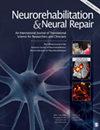Special Issue: Novel Technologies for Recovery after Neurological Injuries.
IF 3.7
2区 医学
Q1 CLINICAL NEUROLOGY
引用次数: 0
Abstract
This Special Issue provides a glimpse into the burgeoning and exciting field that pairs technology with neurorehabilitation. We wanted to provide an overview of the novel measurements, interventions, and future that such a pairing is meant to accomplish. In the first paper in this special issue, Putrino and Krakauer survey technology-based approaches and their efficacy in reducing impairment in neurological conditions. They argue that neurotechnology is uniquely suited for impairment reduction as compared to conventional rehabilitation, which focuses primarily on activity and participation. They also argue that technology will best accomplish this goal when it is used to develop new behavioral interventions and not just adjuvants for regular rehabilitation. For this project to succeed, they maintain that neuroscience must be in the driver’s seat, not engineering. Two of the papers focus on vagus nerve stimulation (VNS), a rapidly emerging modality that targets neuroplasticity mechanisms and is typically paired with rehabilitation interventions. Dawson and colleagues explore why participants in clinical stroke trials might differ in their response to VNS therapy. They found that outcomes were similar across subgroups varying by age, sex, impairment level, severity, time after stroke, stroke location and paretic side. This suggests that VNS effects are consistent across a wide range of stroke survivors. In the next paper, in an attempt to provide a less-invasive form of VNS, Badran and colleagues tested the effects of transcutaneous auricular VNS in a cohort of participants after stroke. The unique aspect of their approach is that stimulation was synchronized with movement during motor rehabilitation using an approach called motor activated auricular vagus nerve stimulation. They found that synchronized stimulation resulted in greater improvement on the Fugl-Meyer Assessment compared with unpaired stimulation despite the reduced number of stimulation pulses required. Thus, while VNS is an important new adjuvant to rehabilitation, stimulation timing matters. In an invasive approach in a rat model of focal traumatic brain injury, Guggenmos and colleagues explore the therapeutic window of activity-dependent stimulation (ADS). ADS utilizes the timing of action potentials in one cortical area to trigger stimulation pulses in another cortical area, driving greater efficacy in cortico-cortical communication. They found persistent improvement in motor skill when ADS was introduced up to 3 weeks post-injury. This study demonstrates that while this approach is still restricted to laboratory animals, it might be implemented in a clinically relevant time frame, and does not require pairing with specific rehabilitative training. Finally, Ganguly and colleagues explore new ways to characterize hand and arm kinematics using electromagnetic orientation sensors implemented in a custom glove, a significant improvement on optical approaches particularly for object interactions. The validity of this approach that was documented in the study suggests that sensor-based measurements might be used in the future to quantify improvements in movement quality, the development of compensatory movements, and development of abnormal movement synergies during recovery especially during real-world functional tasks that involve interactions with complex objects. We are hopeful that the data and ideas shared in this issue serve to highlight the rapidly changing technological approaches that will drive neurorehabilitation. Additionally, we are hopeful that these data and ideas can eventually lead to improved patient outcomes. 1186235 NNRXXX10.1177/15459683231186235Neurorehabilitation and Neural Repair research-article2023特刊:神经损伤后恢复的新技术。
本文章由计算机程序翻译,如有差异,请以英文原文为准。
求助全文
约1分钟内获得全文
求助全文
来源期刊
CiteScore
8.30
自引率
4.80%
发文量
52
审稿时长
6-12 weeks
期刊介绍:
Neurorehabilitation & Neural Repair (NNR) offers innovative and reliable reports relevant to functional recovery from neural injury and long term neurologic care. The journal''s unique focus is evidence-based basic and clinical practice and research. NNR deals with the management and fundamental mechanisms of functional recovery from conditions such as stroke, multiple sclerosis, Alzheimer''s disease, brain and spinal cord injuries, and peripheral nerve injuries.

 求助内容:
求助内容: 应助结果提醒方式:
应助结果提醒方式:


